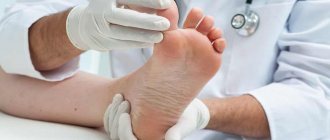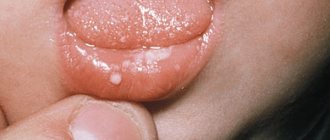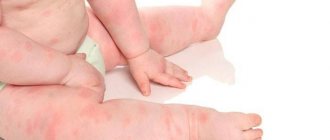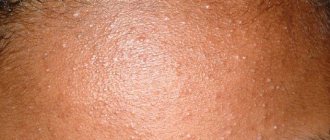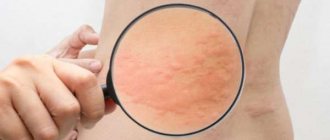Causes
Thermal urticaria is directly related to the release of biologically active substances into the blood , under their influence the capillaries expand , and itchy blisters appear on the skin.
They can be of various sizes and diameters; the pathology itself does not manifest itself.
Scientists identify several provoking factors :
- Disturbances in the functioning of internal organs (liver, kidneys, thyroid gland).
- Stressful situations . Nervous tension promotes the production of certain hormones, body temperature rises, and profuse sweating causes skin rashes.
- Exposure to external negative factors (taking a hot bath, prolonged exposure to direct sunlight, overheating).
- Excessive physical activity . The whole body is on the verge of its capabilities, with the help of rashes on the skin it lets you know about the problem.
Important ! Any cause of heat urticaria is supported by a genetic predisposition to the disease.
Tests for chronic urticaria
Diagnosis of urticaria itself does not require laboratory confirmation (unlike diagnosis of the causes of urticaria).
A detailed examination of patients with chronic urticaria is explained by the need to exclude serious diseases, the symptom of which may be urticaria (for example, diseases of the liver (hepatitis) and gastrointestinal tract, chronic diseases of the ENT organs, systemic lupus erythematosus, tumors, etc.
).
Mandatory laboratory tests include clinical and biochemical blood tests, general urine analysis, ultrasound of internal organs, and stool analysis to detect helminths.
Consultation with the following specialists is indicated: gastroenterologist, otolaryngologist, endocrinologist. After analyzing the examination results, the doctor determines treatment regimens and methods for treating urticaria.
Characteristic symptoms
The appearance of thermal urticaria depends on specific reaction to overheating. The usual localization of rashes on the body is the upper body, arms. Appears immediately after exposure to a negative factor. Girls are most often susceptible to this type of illness, although the pathology can manifest itself in absolutely anyone.
Heat urticaria in adults is almost no different from the clinical manifestations of the disease in children. The difference lies in the severity of the body's reaction to the stimulus.
Characteristic symptoms:
- the appearance of blisters on the skin with a diameter of no more than 5-10 mm;
- temperature increase;
- in rare cases, nausea, vomiting, and problems with stool are observed.
All manifestations are noticeable within a few minutes after contact with the irritant.
For convenience, doctors distinguish several forms of heat illness .
Knowing the exact diagnosis, appropriate treatment is prescribed.
Only then the chances of a quick recovery increase significantly:
- Cold urticaria . It is characterized by an allergic reaction to contact with cold air or even food (science knows of cases when, after drinking a glass of a cool drink, a person breaks out in a rash).
The pathology is accompanied not only by blisters and itching, the patient experiences constant nausea, chills, body aches, and headaches. - Solar urticaria . From the name it is clear what causes the disease; exacerbations are most often recorded in the spring and summer.
Blisters almost always appear on open areas of the skin and are small in size. A severe form of the pathology is fraught with loss of consciousness and serious complications. - False urticaria . This type of symptoms is similar to the manifestations of heat illness, but is caused by internal problems with the kidneys, liver, and stomach.
Almost always, the patient feels unwell, rashes appear on the body, other symptoms depend on the specific ailment.
Are there non-medicinal methods to reduce fever?
In fact, these methods are known to many and allow you to fight fever no worse than medications.
Cool air in the room. If you have a fever, do not close all the windows tightly. On the contrary, ventilate the room as often as possible. The most optimal air temperature is considered to be no higher than +20 degrees.
Wet air. The body will lose fluid in dry air. Moreover, the mucous membranes and skin will dry out, as a result of which the itching and burning will only intensify.
If you don’t have a humidifier, then hang wet towels by the bed the old fashioned way and wipe the floor more often. For any person, the ideal humidity is 60%.
Drinking frequently and heavily. Soda and sweet juices are not suitable for these purposes. Water, compote, tea with lemon, fruit juice - these are ideal options.
If your child doesn’t want to drink, then be smart, because drinking is a must! Dehydration is as dangerous as Quincke's edema.
You shouldn't eat a lot. If a child refuses to eat, there is no need to force feed. Remember, overcooking food will only increase your temperature. Better drink.
Don't wrap yourself up. If you have as many exposed areas of your body as possible, this will promote heat transfer. Just make sure you or your child don't get cold.
Limit movement. Sit down, read a book, watch TV. Don't run around the house doing things. It is difficult to calm children down, but it is necessary because the amount of heat in the body increases with movement.
Photo
Heat urticaria: photos of the disease in adults are presented below.
What should you definitely not do?
Could there be anything better than rubbing? – this is what our grandmothers and mothers think. Remember, you cannot rub your body: neither with vodka, nor with a cold towel, nor with anything, since there is a possibility of vascular spasms.
Vodka or alcohol, even through rubbing, penetrates the body, causing poisoning. Do you want to poison a child? We think not.
Remember, rubbing takes place only after the doctor’s permission and only after taking special medications that reduce vascular spasm.
If you really want to wipe yourself with something, then do it with just water, at room temperature, and only when the child or you tolerate it well.
Diagnostic measures
If you notice such a pathology, be sure to consult a doctor ; it is almost impossible to cope with the problem on your own. Frequent reappearance of the disease is fraught with a sharp rise in body temperature and other complications.
To make a diagnosis, the doctor carefully examines the patient’s clinical picture and asks after what event the rash appeared on the skin. An important role is played by the hereditary factor.
For thermal urticaria, the effect of heat on the human body is often used ; thanks to an interesting technique, the pathology is quickly identified and the correct treatment is prescribed .
Reference! At home, you can determine if you have the disease : put your hand under hot water (not boiling water, no burns needed), hold for five minutes; if rashes appear in this area, you are the owner of an allergic reaction to heat.
Diagnostics
If you experience symptoms of heat urticaria, you should make an appointment with a dermatologist or allergist. After a visual examination and questioning of the patient, the doctor will prescribe a series of tests that will help identify the cause of urticaria.
These include:
- the patient’s hand is lowered into a bath of hot (48-500C) water for 3-5 minutes or a glass with liquid heated to the same temperature is applied to the forearm;
- a person is asked to exercise for 20-30 minutes on an exercise bike or treadmill to provoke sweating and an increase in body temperature;
- Acetylcholine is injected subcutaneously, which in the presence of cholinergic urticaria gives a reaction within 20 minutes.
To identify concomitant diseases, the doctor may give a referral for blood, urine, stool, and ultrasound examination of the abdominal organs. In some cases, consultations with other specialists are required: gastroenterologist, immunologist, endocrinologist, neurologist.
Based on the research results, the dermatologist makes a final diagnosis and prescribes treatment.
Treatment options
to get rid of urticaria forever ; the disease is a specific reaction to thermal irritation of the body.
With the help of medications and folk remedies, you can stop the symptoms of the pathology and cope with itching.
Compliance with certain preventive measures will help prevent the recurrence of the disease.
If heat urticaria occurs, treatment differs from methods used for other forms of the disease. Taking conventional antihistamines is an ineffective way to combat the problem; the emphasis is on cooling gels and ointments . Lubricate the skin with the necessary medications several times a day, follow the doctor's instructions.
The most important aspect is eliminating the allergen , this applies to all types of urticaria. Avoid what your body does not like: a negative reaction to the sun - wear light, closed clothes, a wide-brimmed hat, a rash appears as a result of taking a hot bath - take a cool shower.
Only when complications occur (conjunctivitis, rhinitis) is the help of antihistamines required . In all other cases, avoid taking large amounts of drugs.
Attention ! Chronic pathology requires a detailed study of the causes; it is impossible to correct the situation by stopping the symptoms alone.
Effective external remedies
- Fenistil . The drug eliminates severe itching and dry skin within 15 minutes after application. The cooling effect of the gel quickly relieves discomfort, skin rashes do not leave a trace.
- La Cree . Natural ingredients gently relieve swelling, cope with skin itching, and have a pleasant aroma. The drug is approved for use by children, pregnant women, and persons who have contraindications to the use of other medications.
Folk recipes
- Ingesting celery juice works great for treating heat urticaria . The product must be fresh, consume 100 ml three times a day for one week. Carry out manipulations half an hour before meals.
- Itching is relieved by lotions made from dill juice . Only fresh juice is suitable, moisten a cotton swab with it, wipe the affected areas of the body. There is no need to rinse off the useful product.
- To prevent the appearance of rashes on the skin while taking a bath a liter of chamomile decoction into it . The healing properties of the product have an anti-inflammatory, healing effect.
How to identify an illness in a baby?
Quick identification of urticaria will allow you to get rid of the disease in a short time, and delay in treatment can lead to complications and the transition of the acute form of the disease to chronic.
The disease can be differentiated by its causes and clinical picture. Let's analyze the main forms of urticaria and the nuances that need to be taken into account when treating the disease:
What drugs cause the disease?
It should be remembered that any medications can cause a skin rash, even those that have already been successfully taken several times.
If you were allergic to a drug many years ago, it can occur every time your body interacts with a similar substance.
Antibacterial drugs that have side effects such as urticaria:
Other medicines:
Sometimes the same substances cause the rash to reappear in fixed areas.
